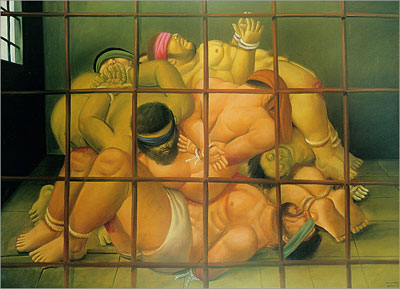I came across these paintings the other day by Fernando Botero and remembered being very moved by them when I fist saw them some years ago. The emotions I experienced when viewing them ranged from gut wrenching horror to feelings of pity and shame for both the tortured and those doing the torturing. I am sure that the article that influenced this set of 50 paintings, Seymour M. Hersh‘s Torture At Abu Ghraib, has not been forgotten by the International community nor have the actual photographs been put to rest. How could they? Such dishonor, such humiliation, such gross violation of human rights and all at the hands of soldiers representing the United States of America, a country that helps people, not hurt them!
Botero responded to Hersh’s article by saying, “I, like everyone else, was shocked by the barbarity, especially because the United States is supposed to be this model of compassion.” He was so upset about the injustices done in Iraq that he began creating a series of paintings that would forever mark these atrocities upon the collective consciousness of humanity. Each are titled Abu Ghraib and numbered 1 -50. The series is based upon actual testimonies that came out of the prison scandal but are his own interpretations of those events. Botero elected not to forgo his signature style of cartoon like characters, but instead uses the style to highlight the vulnerability of his subjects which are large, muscular, and exposed. They are bare and easily hurt.
Unlike the original news photographs, Botero’s prisoners seldom see their abusers nor does the viewer. These prisoners are beaten, tortured, urinated on, and humiliated from outside the picture frame. For example, in this painting, two soldiers are in attendance. The presence of the one on the left side is marked only by the urine that is projected onto the victims whose heads are sacked. The other soldier pins a prisoner down with his boot. 
In another painting a naked prisoner is tied to his cell wall as though crucified with women’s underwear left on his head like a hood. 
We also see naked, hooded and bound Iraqis heaped in a pyramid along with paintings of prisoners being attacked by dogs.
When this series first appeared in 2005, Botero had a difficult time finding American galleries who would show the work. As a result, they were first shown in Europe. Then, they finally appeared in New York, and later they were shown at the University of California, Berkeley. Botero refused to sell the work to collectors commenting that he did not want to profit from the pain of others. He has since donated the collection to Berkeley because he wanted it to remain in America, for American viewers as a “reminder.”






It’s great that Botero finally turned political (in Colombia, too), and moved on from being The Rich Man’s Beryl Cook.
Many thanks to Fernando Botero for this series of paintings. He has held a mirror up for the United States to take a soul searching look into what was done in our name at Abu Ghraib Prison in Iraq. It has ripped at the fabric of who we are, many things have since the year 2000 arrived. Art work such as this is very gut wrenching for the viewer, but even more so for the artist. I know that well, I have tackled lots of other difficult historical subject matter in my paintings and sculpture. Often I cry as I work, but realize that the truth of our sometimes very troubled, often criminal society needs recorded so others in the future will have a window into what really was happening at this time, not a sanitized version of it (as you could find in the new George W. Bush library). One new item that I would like to offer up about Abu Ghraib Prison is that while I was researching the actual ballots from Ohio’s stolen 2004 election I found a military ballot mailed by a solider with a return address of Abu Ghraib Prison. This was a Franklin County (Columbus) record. It appeared to have arrived on time, and it was never opened, thus the soilder’s ballot was never counted. Again, another moment for tears. I hope enough artists will record the difficult stories on the Earth so that people stop being villains, if for no other reason than that they do not want to forever be remembered for the pricks that they were and are.
I was wondering if you would write about painters using photographs as references. When is it stealing and when is it appropriation?
HOW ABOUT SOME MORE